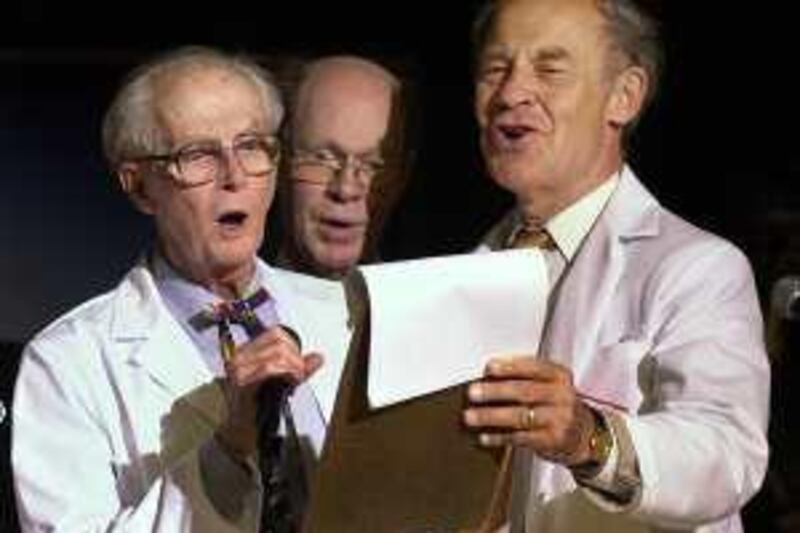On Thursday, a select band of scientists will find themselves in the media spotlight as the latest winners of a prize for discoveries celebrated the world over. No, not the Nobel Prize, which is increasingly awarded for advances that barely anyone apart from the winners can understand. When it comes to making headlines, that most prestigious of prizes now routinely loses out to the far more entertaining and accessible Ig Nobel prizes given for research which "First makes people laugh and then makes them think".
Since their launch in 1991 by the satirical US-based science magazine Annals of Improbable Research, the "Igs" have become a highlight of the scientific calendar, taking place a few days before the announcement of the real Nobels. The prizes are handed out by genuine Nobel laureates at an anarchic ceremony at Harvard University, with many of the winners turning up to accept their award in person.
The range of breakthroughs that have merited the prize is certainly impressive. In 2001 the physics award went to Dr David Schmidt of the University of Massachusetts for his research into why shower curtains tend to billow inward, while the 2005 Ig for psychology went to a team at Keio University, Japan, for training pigeons to discriminate between the paintings of Picasso and Monet. Not everyone has seen the funny side of the Ig Nobels, however. In 1995 a team of British researchers won the physics Ig for research into why breakfast cereal goes soggy - prompting some newspapers to ask why taxpayers' money was being wasted on such trivial research. In fact, the project had been funded by a leading cereal maker rather than the UK taxpayer and had an entirely serious purpose: consumers prefer cereal that keeps crunchy as long as possible.
Even so the controversy led Britain's chief scientist, professor Sir Robert May, to ask the organisers not to award any more Igs to UK researchers, who were emerging as embarrassingly frequent winners of the prizes. With maintenance of reputation being so important among scientists these days, Sir Robert's request was understandable. But it also ignores the fact that many major scientific advances have come from research into "trivial" questions.
The best-known example is Newton's discovery of the law of gravity after he saw an apple fall in his mother's garden. Some historians now suspect Newton invented the story to allow him to claim priority over his rival, Robert Hooke. Be that as it may, Newton clearly did not have any qualms about claiming inspiration from a "trivial" event. Around the same time, the distinguished French mathematician Blaise Pascal was approached by a shady French aristocrat named Chevalier Gombaud Antoine de Méré about an equally trivial issue: how best to win at a game of dice. Pascal teamed up with a fellow mathematician named Pierre de Fermat to solve the problem and together laid the foundations for one of the most important branches of mathematics: probability theory.
During the 1920s, the French mathematician Emile Borel pondered the best way to win games like poker and hit upon the tactic of minimising losses in the worst possible circumstances - the so-called minimax strategy. This opened the way to what is now called game theory, which is used by everyone from military strategists to governments auctioning off assets - and, of course, poker players. More recently, the sight of a plate spinning through the air in a university cafeteria was enough to set the American physicist Richard Feynman on his way to a Nobel Prize. Intrigued by its rapid wobbling, Dr Feynman analysed the problem mathematically and showed that as long as the wobbles are small, they occur at twice the spin rate of the plate. Delighted by his discovery, he told his friend and colleague Hans Bethe - who thought it was all rather, well, trivial. Yet it inspired Dr Feynman to investigate the spin of the electron which, in turn, led to work on quantum electrodynamics for which he won a share of the 1965 Nobel Prize for physics.
So what "trivial" discovery is likely to lead to a future Nobel? One candidate is the phenomenon which has already won an Ig for Professor Dorian Raymer and Dr Douglas Smith of the University of California, San Diego. They won last year's physics Ig for investigating an effect noted by the Victorian humorist Jerome K Jerome in his celebrated comic novel Three Men in a Boat. One of the characters observes that unless rope is very carefully handled, it can end up in a hopelessly tangled mess.
During the 1960s biochemists pointed out that the same phenomenon occurs in string-like molecules like DNA, which can also become tangled. For living organisms, this is more than just inconvenient: knots can prevent the genetic code being correctly read, with potentially deadly results. It has since been discovered that cells contain enzymes which target tangled regions of DNA, cut them apart and reconnect them free of knots. But it is possible that nature has evolved other ways of keeping string-like molecules untangled. This is now a major focus of investigation by researchers such as Andrzej Stasiak and his colleagues at the University of Lausanne. Already some antibacterial and anti-cancer agents have been found that work by affecting the anti-knotting abilities of DNA.
Some of the scientists who find themselves awarded Igs on Thursday might prefer to have won the "real" thing. They might even worry about being looked down upon by their peers. Yet whether it is the spinning of a plate or the tangling of DNA, the truth is that nature herself doesn't understand the meaning of "trivial". Robert Matthews is Visiting Reader in Science at Aston University, Birmingham, England






